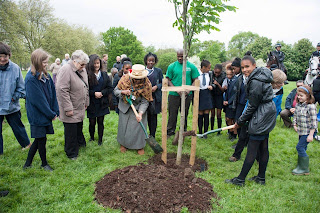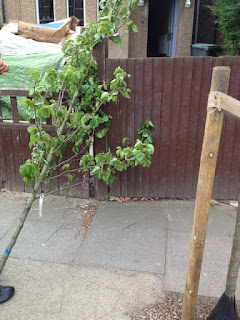Have you every thought about those tarmac'd spaces that are all that's left after a street tree has been removed? They are very important markers for us, and spaces that we keep our eyes on, waiting to get them back in use again. Thankfully, our colleagues in Green Scene in the council have them all listed on Arbortrac, their tree tracking software.
Over the last few years, the edges of our pavements have been under relentless pressure from the utility companies (and now, fibre optic broadband providers). This has resulted in a considerable loss of existing tree pits in some parts of the borough.
A few months ago (when Skanska started to survey Lewisham streets for the placement of the new street lighting that you will have seen going up all over the borough) we noticed that one of our tree pits in Harefield Road had acquired a bright yellow symbol:
We got on to Green Scene straight away which resulted in a timely meeting between them and the Skanska management, which produced a good result:
"Ward by ward, all columns are to be replaced, however, old column locations do not, in themselves, dictate new placements - rather column distancing and compliance with legislation pertaining to street lighting levels does.
The potential effects of placing columns very close to, or in, tree crowns were discussed and all agreed that the ideal is that, as far as possible, column positioning avoids tree canopies. It is appreciated that there are site by site considerations - e.g. not all of the trees affected will be LBL trees and other street furniture prohibits column placement, etc. Paradoxically there are crossover issues for both column and tree planting. It was also agreed that information exchange and better communication flow could do much to negate problems.
Further to the above, we have supplied them with tree information from our database so they can create layered maps to compare with their existing project maps therefore are able better plan and address tree/column issues.
We have emphasised that due to the wide range of other pressures on tree planting in general, and the apparent loss of previous tree pits which no longer appear viable, that pits are a precious commodity, therefore these sites can not afford to be lost to lamp columns …"
At the time of writing this blog post, the shiny new lamp post that appeared in this tree pit in Harefield Road has not acquired a lamp, so we are hoping that Skanska will relocate it before wiring it up.
As you can see, we are helping Green Scene keep on top of these silent tree pit losses, and we would appreciate your help too! The more eyes we have on those pits, the more we can protect them for future re-planting.
If you've got a few minutes more, have a look at the amazing technology now available to contractors when planting trees (like the high-value site documented outside the Old Bailey in the city):
Greenleaf - specialists in tree pit design
Postscript - July 2014 - Sadly, after much consultation with SKANSKA we have had to relinquish this valuable tree pit. There were too many conflicting constraints on maintaining this pit and, sadly, this means that the lamp had to be located here.





























